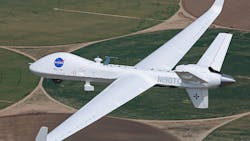NASA flies its SkyGuardian UAV over Southern California
In this week’s roundup from the Association for Unmanned Vehicle Systems International, which highlights some of the latest news and headlines in unmanned vehicles and robotics, NASA flies a new UAV, real-time drone tracking, and university grants to advance drone technology.
GA-ASI flies SkyGuardian RPA in NAS above Southern California as part of joint demo with NASA
As part of a joint flight demonstration with NASA, General Atomics Aeronautical Systems Inc. (GA‑ASI) flew its SkyGuardian Remotely Piloted Aircraft (RPA) in the skies above Southern California on April 3.
Since 2014, GA-ASI and NASA have worked together to prove the safety of flying large UAS in the National Airspace System (NAS). GA-ASI was selected to participate in NASA’s Systems Integration and Operationalization (SIO) activity, which includes multiple flight demonstrations that focus on different types of UAS and their respective flight environments.
“Our work with NASA is opening the eyes of regulators to the safety and utility of unmanned aircraft systems in the performance of certain tasks for public and commercial good,” says Linden Blue, CEO, GA-ASI.
“The SIO demonstration highlighted how the aircraft can be used for many other civilian and commercial missions.”
SkyGuardian took off from GA-ASI’s Gray Butte Flight Operations Facility near Palmdale, California, and flew through the Southern California NAS towards Yuma, Arizona while being operated by a remote pilot based at Gray Butte. Situational awareness of air traffic near the UAS was provided by the GA-ASI-developed Detect and Avoid System (DAAS), which includes a Traffic Alert and Collision Avoidance System (TCAS II) used in manned aircraft that fly in civil airspace. The DAAS can also provide detection and tracking capability of any nearby aircraft which may not have active transponders thanks to being equipped with an air-to-air, “Due Regard” Radar.
The DAAS allowed the remote pilot to “see” and navigate around airborne traffic just like an airborne pilot.
During the demonstration, GA-ASI showcased how SkyGuardian can be used for a variety of commercial and public services applications, using its onboard sensors. These applications included inspections of hundreds of miles of rail, power line, communication and canal infrastructure, agriculture monitoring and topological surveys, and wildfire and flood monitoring.
“NASA’s goal to help accelerate routine UAS operations into the national airspace has moved one step closer with this successful flight demo,” says Mauricio Rivas, UAS integration in the NAS project manager at NASA’s Armstrong Flight Research Center.
“Our efforts with General Atomics and our other SIO industry partners will help commercial UAS move closer towards certification.”
Honeywell and Collins Aerospace were GA-ASI’s technology partners for the demonstration. Honeywell supplied the TCAS II for the DAAS, while Collins Aerospace supplied the Command and Non-Payload Communications (CNPC) datalink radios, which is part of the Command and Control datalinks system.
Skyward’s Live Flights allows companies to track their drones in ‘essentially real time’
Skyward has unveiled Live Flights, which is a new service that allows a company to track all of its drones in what Skyward calls "essentially real time."
A user can access the new Live flights map from either the company’s website or its app, where every one of their drone’s location and flight path is shown over the last 60 seconds.
When an aircraft is clicked on the map, detailed information is brought up including aircraft ID, location, altitude, and velocity, as well as “key pilot information.”
Skyward says that these new capabilities will be the basis for launching a remote ID service.
“Live Flights serves as a foundation for Skyward’s implementation of Remote ID. With the ability to transmit live position and identification data, Skyward aims to become a Remote ID UAS Service Supplier (USS),” the company explains.
“Today, Skyward lets program managers know who’s flying and where, improving visibility and compliance for enterprise drone programs. Tomorrow, we look toward a system of Universal Traffic Management in the National Airspace System.”
The company notes that at launch, Live Flights supports only aircraft from DJI, but the company says that support for other makers is “planned for the future.”
FAA awarding $2.6 million in grants to universities to advance drone ops
U.S. Transportation Secretary Elaine L. Chao recently announced that the FAA is awarding $2.6 million in research, education, and training grants to universities that make up the agency’s Air Transportation Center of Excellence (COE) for UAS, which is also known as Alliance for System Safety of UAS through Research Excellence (ASSURE).
The grants are designed to advance specific goals and projects.
“The research funded by these grants will provide valuable data as the Department leads the way to chart a course for the safe integration of drones into our national airspace,” Secretary Chao said.
“In addition to providing grants, we are also supporting activities that provide operational experience like the Unmanned Aircraft Systems Integration Pilot Program, all of which move us more quickly toward full integration.”
The total of the four grants is $2,578,071. The grants cover the following research projects: UAS Flight Data Collection and Analysis Phase II; UAS Safety Case Development, Process Improvement, and Data Collection; Develop Risk-Based Training and Standards for Operational Approval and Issuance; and Establish UAS Pilot Proficiency Requirements.
The COE universities that will receive the grants include the University of North Dakota; the University of Alaska, Fairbanks; New Mexico State University; Kansas State University; Mississippi State University; The Ohio State University; Oregon State University; and Drexel University. The University of North Dakota will serve as the lead university on two of the research projects, while Kansas State University and Oregon State University will serve as the lead university on a project a piece.
Compiled by Brian Sprowl, Associate Editor, AUVSI
Share your vision-related news by contacting Dennis Scimeca, Associate Editor, Vision Systems Design
SUBSCRIBE TO OUR NEWSLETTERS
